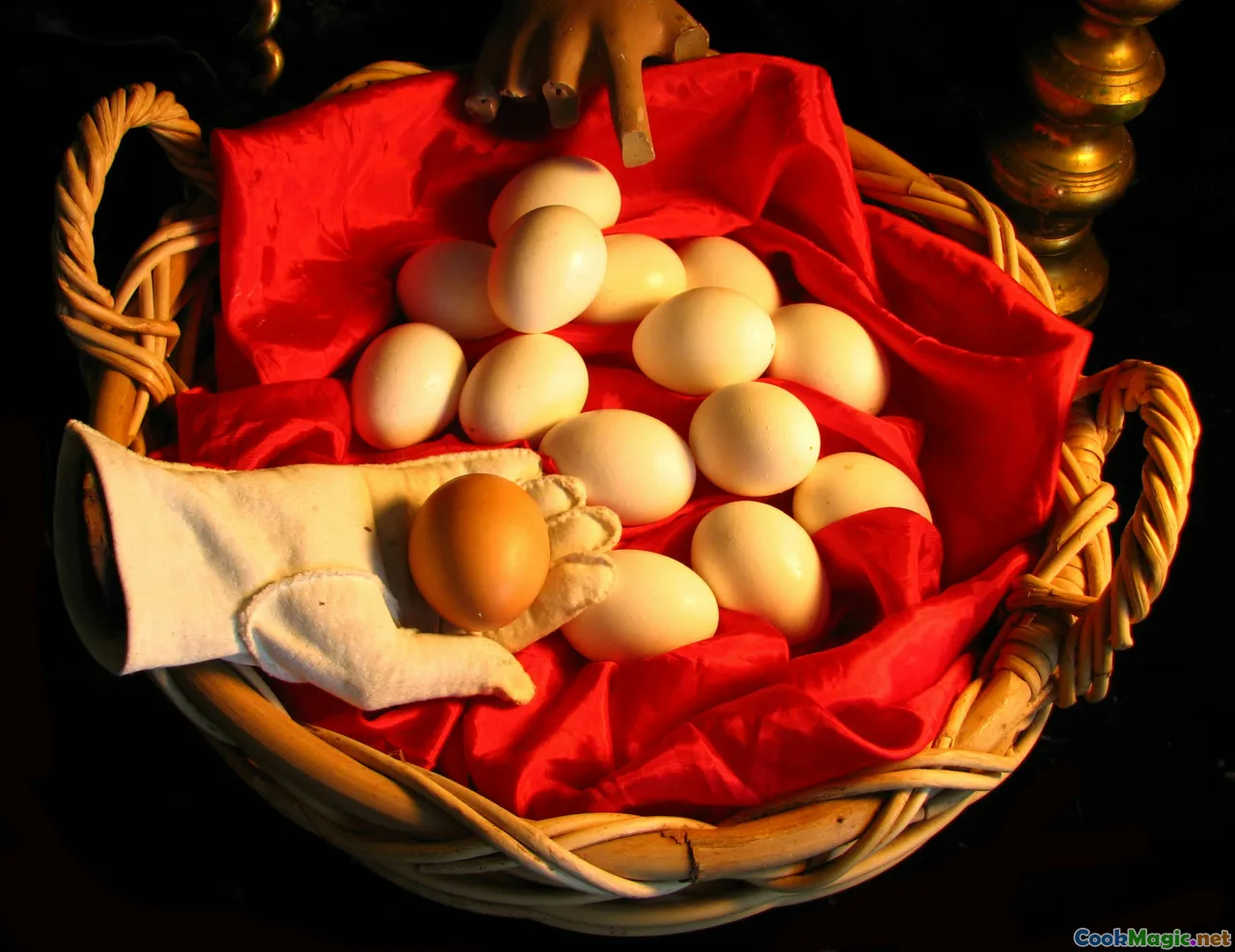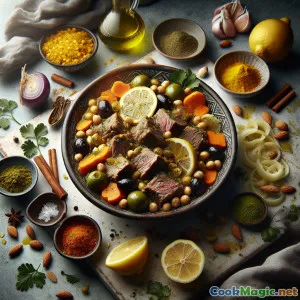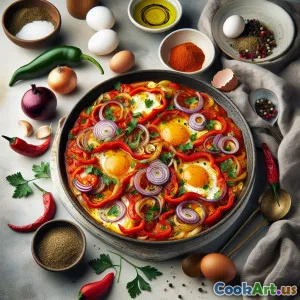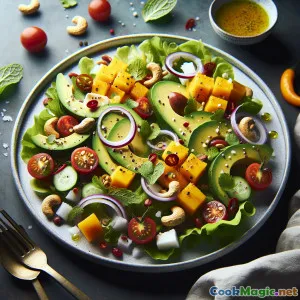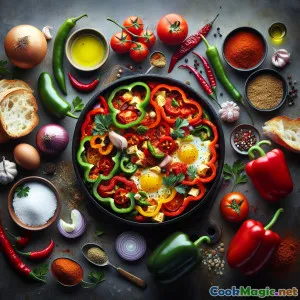
Chakchouka del Sahel: Uova che sfrigolano con verdure saporite
(Sahel Chakchouka: Sizzling Eggs with Savory Veggies)
(0 Recensioni)0
166
ottobre 03, 2025
Segnala un problema
Ingredienti
-
2 medium Peperone rosso
(Seeded and sliced)
-
1 medium Peperone verde
(Seeded and sliced)
-
1 whole Cipolla grande
(Affettato sottile)
-
4 medium Pomodori freschi
(A dadini)
-
3 whole Spicchi d'aglio
(Tritato)
-
1 small Peperoncino piccante
(Tagliato finemente)
-
1 teaspoon Paprika affumicata
(Or regular paprika)
-
1 teaspoon Cumino macinato
(Macinato fresco per il miglior sapore)
-
1/2 teaspoon Semi di coriandolo
(Schiacciato)
-
2 teaspoons pasta di harissa
(or substitute with tomato paste plus chili flakes)
-
3 tablespoons Olio d'oliva
(Preferibilmente extravergine)
-
4 large Uova
(Free-range if possible)
-
1 teaspoon Sale
-
1/2 teaspoon Pepe nero
(Fresco di rottura)
-
2 tablespoons Prezzemolo a foglia piatta
(Tritato, per guarnire)
-
60 grams Formaggio Feta
(Sbriciolato, per guarnire)
-
4 slices Pane croccante
(Per servire)
(Seeded and sliced)
(Seeded and sliced)
(Affettato sottile)
(A dadini)
(Tritato)
(Tagliato finemente)
(Or regular paprika)
(Macinato fresco per il miglior sapore)
(Schiacciato)
(or substitute with tomato paste plus chili flakes)
(Preferibilmente extravergine)
(Free-range if possible)
(Fresco di rottura)
(Tritato, per guarnire)
(Sbriciolato, per guarnire)
(Per servire)
Nutrizione
- Porzioni: 4
- Dimensione Porzione: 1 hearty plate (250g)
- Calories: 330 kcal
- Carbohydrates: 23 g
- Protein: 13 g
- Fat: 19 g
- Fiber: 5 g
- Sugar: 9 g
- Sodium: 700 mg
- Cholesterol: 210 mg
- Calcium: 180 mg
- Iron: 3.1 mg
Istruzioni
-
1 - Start The Skillet:
Heat olive oil in a wide heavy skillet over medium heat. Add the sliced onions and sauté until soft and translucent, about 5 minutes.
-
2 - Add Peppers & Aromatics:
Stir in both bell peppers and the chili pepper, if using. Cook, stirring occasionally, until softened, about 7 minutes. Add the minced garlic and cook until aromatic.
-
3 - Build the Sauce:
Add the diced tomatoes and season with smoked paprika, cumin, coriander, harissa paste, salt, and pepper. Stir to combine. Cover and simmer until the mixture thickens slightly and flavors meld, around 8 minutes.
-
4 - Create Egg Nest:
Make four indentations in the simmering vegetable mixture. Carefully crack an egg into each well.
-
5 - Cook Eggs:
Cover the skillet and allow the eggs to poach in the sauce until whites are set but yolks remain runny (or longer, to your preference), about 6 minutes.
-
6 - Finish and Serve:
Sprinkle with chopped parsley and crumbled feta if using. Serve immediately with warm crusty bread for dipping.
Heat olive oil in a wide heavy skillet over medium heat. Add the sliced onions and sauté until soft and translucent, about 5 minutes.
Stir in both bell peppers and the chili pepper, if using. Cook, stirring occasionally, until softened, about 7 minutes. Add the minced garlic and cook until aromatic.
Add the diced tomatoes and season with smoked paprika, cumin, coriander, harissa paste, salt, and pepper. Stir to combine. Cover and simmer until the mixture thickens slightly and flavors meld, around 8 minutes.
Make four indentations in the simmering vegetable mixture. Carefully crack an egg into each well.
Cover the skillet and allow the eggs to poach in the sauce until whites are set but yolks remain runny (or longer, to your preference), about 6 minutes.
Sprinkle with chopped parsley and crumbled feta if using. Serve immediately with warm crusty bread for dipping.
Ulteriori informazioni su: Chakchouka del Sahel: Uova che sfrigolano con verdure saporite
Chakchouka du Sahel: Sun, Sand, and Satisfying Spice
Chakchouka du Sahel is a spirited adaptation of the classic North African shakshouka, drawing inspiration from the rich bounty and bold traditions of the Sahel region. The Sahel stretches across North and West Africa, an area where culinary ingenuity thrives in extremes of climate and is influenced by centuries of migration and trade. While the roots of classic shakshouka are deeply Tunisian—melting tomatoes, peppers, and eggs in one harmonious pan—this Sahel-focused version infuses the dish with smoky spices, fiery chili, and savory accents that reflect local taste and flair.
History and Cultural Significance
Shakshouka symbolizes community and sharing, often cooked haunch to hip in large, communal skillets. In Sahelian hospitality, the meal is made for crowds and accompanied by rounds of laughter and nibbles of fresh, crusty bread. Traditionally, markets might not be bursting with every fresh vegetable year-round—so the fact that this dish leans heavily on accessible staples like eggs, onions, and preserved peppers makes it both rural and cosmopolitan, especially adaptable for whatever’s on hand.
Harissa, present in this recipe, is another nodes to Maghrebi cuisine, born of chile-loving cooks wanting more depth and heat. If this spicy paste isn’t found in your pantry, a puree of tomato paste, extra chili flakes, and a sprinkle of cumin gets close to the earthy warmth harissa bestows.
Unique Aspects
What distinguishes a Sahelian chakchouka from its better-known Mediterranean cousin? For one, the interplay of sweet and smoky—in this recipe, smoked paprika and crushed coriander recall not only sun-dried peppers but also hot, lovely earth. The addition of crumbled feta is a nod to cultural exchanges with the Mediterranean, softening the load of spice and baking a subtle tang into the gorgeous vegetable base.
Flat-leaf parsley or even local greens, sprinkled on top, brings a whisper of freshness after the heat and incense of the main dish. Village bakers will insist you serve it with torn rounds of ‘kesra’ or long strips of fresh, crusty baguette. It is not simply a matter of mopping up sauce, but an act of completion—every peppery, golden drip needs a vessel.
Top Tips and Notes
- Don’t over-simmer your tomatoes—keep the sauce punchy, not stew-like, to let the vegetables sing.
- Control the fire: If your audience doesn’t fancy spice, replace the hot chili and halve the harissa. The dish retains layers of flavor regardless.
- Vary the vegetables: Sahel-inspired kitchens often bulk up with chopped cooked eggplant, white beans, or, during pulse harvest, some chickpeas for extra protein and happy treble.
- The eggs should poach just as the sauce thickens, capturing yolky golden goodness amid the bubbling red and green.
- Advance meal-prep tip: Prepare the sauce ahead and reheat gently, then poach the eggs fresh just before serving.
Final Thoughts
‘Chakchouka du Sahel’ isn’t just a meal—it’s a symphony composed from humble pantry ingredients, with each spice and garnish a deliberate note. When you gather friends and family around this colorful skillet, you echo generations who have done the same along the centuries-old caravan routes just south of the Sahara. Taste memory collides with modern convenience in the simplicity and generosity of this dish, delighting the senses and filling bellies with sunshine on any continent—especially when accompanied by laughter and good bread.


